Swing Symphony
When Wynton Marsalis was commissioned to compose his third symphony, he took inspiration from composers like Ives, Gershwin, Copland, Bernstein, and Ellington as he sought to create a musical meditation on American ideals. The definitive performance of the resulting, critically acclaimed work—Swing Symphony—is now an album by the Jazz at Lincoln Center Orchestra and St. Louis Symphony Orchestra, conducted by maestro David Robertson.
Commissioned in 2010 by the Berlin Philharmonic, the London Symphony Orchestra, the New York Philharmonic, and the Los Angeles Philharmonic, Marsalis’s Symphony No. 3 is at once invigorating and elegiac, bombastic and introspective, and has been performed by orchestras around the world. This recording, which took place in front of a rapturous, sold-out crowd in St. Louis’s Powell Hall, marks the very first release of a modern classic that captures the full breadth of 20th-century orchestral music and the spirit of American optimism.
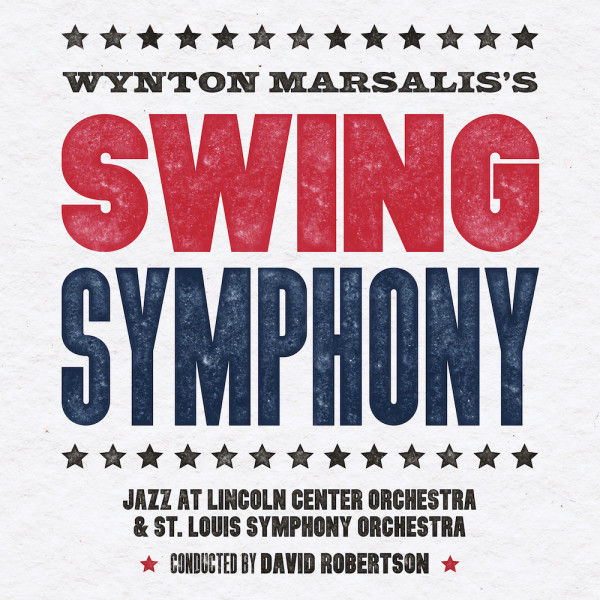
Album Info
| Ensemble | JLCO with Wynton Marsalis and St. Louis Symphony |
|---|---|
| Release Date | July 1st, 2019 |
| Recording Date | May 4-6, 2018 |
| Record Label | Blue Engine Records |
| Catalogue Number | BE0017 |
| Formats | Digital Download |
| Genre | Jazz at Lincoln Center Recordings |
| Digital Booklet | Download (pdf, 4 MB) |
Track Listing
| Track | Length | Preview |
|---|---|---|
| Movement I: St. Louis to New Orleans | 7:52 | Play |
| Movement II: All-American Pep | 10:44 | Play |
| Movement III: Midwestern Moods | 12:01 | Play |
| Movement IV: Manhattan to LA | 10:15 | Play |
| Movement V: Modern Modes and the Midnight Moan | 7:11 | Play |
| Movement VI: Think-Space: Theory | 6:50 | Play |
| Movement VII: The Low Down (Up on High) | 7:37 | Play |
Liner Notes
First of all, there’s the stage set-up; a lot of folks to fit in a compact space. Location, location, location—the same goes for a concert hall or an urban environment. The fundamental, philosophical reach of this question: are you going to separate the two groups or blend them? One way might be to set them on opposing sides, but I don’t think that’s a solution at all. Instead, we placed the band front and center, embraced all around by the orchestra. It’s unusual to have trumpets in front of flutes and oboes; yet here, power, gentleness, and grace all give to each other. Nestled next to the violins, the piano, bass, and drums send out the musical heartbeat. A conductor’s day job is to organize the music’s flow, but my awe at the sheer, perfect precision of Dan, Carlos, and Jason is reverential and unending. When Carlos nods at me, with the merest hint of a smile, I know we have set the tempo in its perfect place. There is no greater joy.
The St. Louis musicians have a huge heart and a dazzlingly wide range of virtuosity, but when the Reeds begin to play, we all become aware of being blessed with the best master-class; in swing, in articulation (the front, middle, and end of a tone – the note’s whole soul, that is), and in how to make phrases of supreme elegance, energy, or elegy. When the Trombones and Trumpets kick in, we learn how taking the air of hardship and blowing it out in just the right way will transform experience into musical metal, inspiring and demonstrating the unbreakable bonds of love. And then, when Wynton’s score asks us to “Swing,” we put our all our force behind it. Sixteen bars later, when the score says “Swing Harder,” this sonic miracle of 95 individual minds working as one goes incandescent, including and exalting everyone within earshot.
This is the best way I know to define sublime.
David Robertson
When I played my first symphony All Rise for the great music director of the Modern Jazz Quartet, John Lewis, he said, “Congratulations! There are a lot of solutions in here… but you still have to figure out how to get more motion in the bass. There are too many vamps—a repeated bass riff is the signature of almost every song you hear today and every song I grew up hearing.” I laughed because many an hour had been spilled over that very problem, and I just couldn’t figure it out without putting the basses in swing time (almost a guaranteed disaster because orchestral basses don’t want to play pizzicato bass notes all night, because of their onstage distance from the ride cymbal, the weight of their sound causing a muddle of successive low notes on every beat, etc.). With Swing Symphony (my third symphony), I decided to put the basses in time and let them work it out. They did a magnificent job and disproved my initial conclusion that they couldn’t swing (because they hadn’t before). It was a useful corrective to conventional wisdom: just because a group of people hasn’t been successful doing something (worth doing), it doesn’t mean they can’t or won’t.
Paul Whiteman’s 1924 Aeolian Hall concert (which premiered Rhapsody in Blue) and Benny Goodman’s 1938 Carnegie Hall concert both include a sequence of pieces representing the bandleaders’ understandings of the history of jazz from its beginnings to that date. Duke Ellington’s 1943 Carnegie Hall concert premiered the landmark Black, Brown and Beige. It told a tonal history of Afro-American music (from work songs to blues to modern swing, including the Afro-Latin tradition) while also presenting Duke’s concept of the social advancement of American Negroes from slavery to the early 1940s. Swing Symphony combines both approaches but focuses on Afro- AND Anglo- American music. It also uses harmonic progressions from some of the most successful songs in jazz and popular music to create a unique conception of form as history. The piece embraces the tradition of integrating jazz with symphonic orchestras (from the concert hall to the Broadway stage). It traces the evolution of the swing rhythm from ragtime to this very moment in order to unite diverse instrumental techniques, musical personalities, song forms, dance grooves, and historic eras. In each movement, I set out to codify and build on successful integrating techniques developed throughout the 20th century and into the 21st. But no matter how deeply you think on the musical and philosophical challenges, practical issues will always force you beyond the theoretical.
For example: the jazz orchestra sits in the belly of the symphonic orchestra—our medium volume is at least two dynamics louder than their medium level. How can we be friendly and not a thundering, hostile invading force? How can we all play in cut time and still groove? Can you use the violas to swing quarter notes like a rhythm guitar? Does New Orleans counterpoint work with the massive stage space occupied by a symphony orchestra? Can you achieve swing without writing corny triplet rhythms? How can we put swing and the blues in the forefront of the music instead of just using them as colors to add spice to styles of music from other countries? What did the forebears of these styles (like Gershwin, Bernstein, Florence Price, Copland, and Still) do to solve these and other problems? Writing pieces with so much complexity and complication forces very concentrated macro-planning and tedious micro-execution. The general outline has to account for everything everyone does for over an hour and then just the dots and dashes (that indicate note values alone) require a lot more detailed work than you can imagine. However, it is enormously gratifying to perform a single piece with so many musicians. I am grateful for the opportunity to play with and for all the members of the St. Louis Symphony, the JLCO, and Maestro Robertson.
Movement I
St. Louis to New Orleans
The symphony begins with the ride cymbal articulating the swing rhythm above a primitive, guttural ground. The aggressive percussion and low instruments represent the underlying violence that makes life so tenuous and serious, while the swing symbolizes an overarching aspiration that gives human existence direction and meaning. Then… we are in ragtime. It is polite parlor music gone rogue using the actual harmonic progression of “Maple Leaf Rag” with odd metered syncopations. We hear the relationship of rags to traditional marches. Sections of both orchestras trade back and forth and ultimately we come together in a raucous rag/stomp before transitioning to a slow drag. This deep, grinding groove is also a march. It is the soundtrack for the raw sexuality of the early music performed in New Orleans’s famous Storyville District. Using the harmonic progression of “Make Me a Pallet on the Floor,” the high clarinet doubles the trumpets an octave above as it probably did in Buddy Bolden’s band. Finally, after joint trumpet fanfares (the traditional second line starts with a trumpet call), a tutti New Orleans parade march ends the first movement, using the harmonies of the traditional New Orleans funeral ending “Didn’t He Ramble.” Marches are something all strings, brass, and percussion grew up playing (even if it was just “Pomp and Circumstance” at graduation).
Movement II
All-American Pep
The drum set is the embodiment of American practicality, ingenuity, and sass. You only have to pay one person to do five things. And the four limbs plus all of them together equals five. Here, I apply the progression and rhythm of the song “Charleston.” That rhythm is syncopated in many different ways, and both Jason (our jazz drummer) and the orchestra’s percussion section play “trick” or “junk” drums, using everything but the kitchen sink. A transition with rhythm breaks takes us into a slow, Argentinian tango based on the progression of popular song “El día que me quieras.” Tango has a fantastic string orchestra tradition and there are many natural and easy connections with jazz. The habanera bass ostinato and straight four- four time are a couple of fundamentals tango shares with New Orleans jazz. This section makes use of sweet, romantic violins with contrapuntal underpinnings and internal voice leadings that I always loved hearing my father play on the piano. It transitions through the singing trombone (á la Tommy Dorsey) and goes into a big, upbeat final section—an optimistic, post-Depression, “Happy Days Are Here Again” mood fit for Broadway. There’s the “Seventy-Six Trombones” raucousness of our two juxtaposed trombone sections, the powerful French horns, and the woodwinds dancing all around up high. It is inspired by Leroy Anderson’s “Sleigh Ride,” another great piece that had probably been played by everyone on the stage (and has been heard at every high school band Christmas concert that has ever been played in America).
Movement III
Midwestern Moods
We start with Kansas City-style swing, which features riffs (snappy, repeated phrases) and call-and-response between saxes and brass over a swinging rhythm section. This is a dialogue between jazz and symphonic orchestras like what the Basie Band would do when they rose up out of the Midwest to swing the Great Depression away: brass vs. the strings vs. the reeds vs. the brass. “Topsy” is the underlying harmonic progression. It features the two tenor saxophones (like Lester Young and Herschel Evans in Basie’s band), the counterpoint of multiple riffs, and a large call and response between symphonic and jazz orchestra. We come together and transition to a ballad feel. This is written for the saxophones in call and response with the celli. It is built on the chord progression of “Body and Soul,” which was given an abstract and very popular treatment by Coleman Hawkins, the father of the saxophone. He was also a cellist with no possibility to work before the Civil Rights Movement. Here, the lead voice frequently goes back and forth between members of the sax section and between the saxes as a section and the celli. It resolves with solo cello and saxophone playing together. Percussion transitions us to Duke Ellington’s “jungle style,” which also found voice in Benny Goodman’s “Sing, Sing, Sing,” the definitive anthem of the swing era. Drums- drums-drums are featured, and we return to the primal chanting of the first movement. There is a clarinet solo (a nod to Benny Goodman) and trumpets, of course. The vibes are in there for Lionel Hampton. (I actually played a gig with Lionel Hampton’s big band instead of attending my senior prom. The great Jimmy Maxwell—who played lead trumpet with Benny Goodman in the late thirties—was lead trumpet that night and took care of me like I was his grandson.) After the timpani and drums lead us through the asphalt jungle, we go home with a big ensemble swing section with every musician playing together. It’s the first time we all really fall into the swing groove—the basses are walking, the cymbal swinging, violins and woodwinds riffing up high, the celli and the violas playing like Freddie Green rhythm guitar, and call and responses up through the orchestra brass section. We end with the same quasi-primitive chant with which we started.
Movement IV
Manhattan to LA
The fourth movement starts with frenetic New York City bebop, the first real American virtuosity to embody the velocity and psychological complexity of the 20th century. Inspired by the genius of the mercurial Dizzy Gillespie and Charlie Parker—who Dizzy told me was “the only musician in history whose fast music is also a melody through and through”—this movement features a very challenging trumpet passage and breaks. Dizzy and Bird, of course, played on breaks all the time. The strings play bebop’s intricate lines as translated through the style of the Quintette du Hot Club de France, which featured violin virtuoso Stéphane Grappelli. Then we go to the mambo, a definitive style of the mid-20th century. Papo Vazquez and Carlos Henriquez helped make sure this was not corny. It is inspired by Machito, Chico O’Farrill, and all of the great musicians in that tradition. I had many good meals in Chico’s home, and we spoke about this type of integration as we discussed possibilities and looked at scores. The last section utilizes the harmonies of Benny Carter’s “Bijou.” It features the bittersweet ruminations of Sherman Irby on the alto saxophone. It’s a sweet, late-night ballad that’s gets to the point. Long ago, we had the good fortune to play under Benny’s baton and I had the opportunity to know him and to learn from him. He was a master of reeds and trumpet as well as of arranging and composing. That’s why he was called “King of the Musicians.”
Movement V
Modern Modes and the Midnight Moan
This begins with a quasi-fugue and no underlying harmonic progression. It’s inspired by the type of music Gunther Schuller, John Lewis, and George Russell were working on in the 50s. (Gunther auditioned me for Tanglewood when I was 17. He let me into the program and was also a great mentor and example for me throughout my life.) Many voices enter and stretto before an improvised section with four voices in modern New Orleans counterpoint. We transition into a challenging bass passage accompanied by sparse woodwinds. Charles Mingus’s inventive changes for “Goodbye Pork Pie Hat” provide the underlying harmony. It has to be tricky or Mingus won’t respect it. Then we move into the harmonies from “So What” by Miles Davis: a minor chord that moves up a half step and then back down. The swing is influenced by Coltrane’s Quartet combined with a melodic conception influenced by New Orleans drummer James Black. I was born hearing his music, which is defined by deep soul, Crescent City sophistication, and masterful odd-meter grooves.
Movement VI
Think-Space: Theory
The sixth movement focuses on the type of introspection that came into jazz through Bill Evans, Thelonious Monk, Wayne Shorter, and Herbie Hancock. Because the woodwinds have yet to be featured as a section, and because they are given to introspection (with all of those keys), this begins with them. Scraped cymbals, Harmon-muted brass and intense harmonies accompany the oboe in a typically singing solo role… but on unusual melodic and harmonic material (on the oboe). The movement transitions to a section based on Elvin Jones’s groove on John Coltrane’s “Wise One.” (Elvin Jones was one of my deepest and most beloved mentors). The percussion plays what Elvin might do and the bassline is the type of thing that Jimmy Garrison might play. Soprano sax leads the saxophone section in dialogue with the French horns. Finally, the strings come in, answering with a pizzicato section to create a three-way counterpoint. The woodwinds are running up and down their horns with the virtuosity and harmonic sophistication of Trane’s challenging lines. At the end of the movement, themes from the entire symphony to this point are recalled. Rhythms and styles are interwoven in a collage. All sounds stagger and then at once fight over a church-y groove as a barely audible New Orleans march runs through everything. It is the type of cacophony sometimes confused with modernity, but is actually just a brisk, open-eared afternoon walk up any trafficked avenue in New York City.
Movement VII
The Low Down (up On High)
The last movement opens with a contemporary American pastoral scene, populated with common musical concepts of today: the movement of chordal harmony, varied rhythms and times, stomps and claps, vamps influenced by funk, and the use of the blues. These styles are not unique to any single specific era of jazz. I’m always interested in distilling and consolidating the past and seeing it as an integral part of the present in which we live. I don’t believe that youth is itself a value—it makes you envy yourself for absolutely no reason as you grow older. There is no need to segregate you from yourself just to avoid a little studying. The horns (using mutes) represent the revolution of Earth, and the real high soprano saxophone reminds me of children. The woodwinds recreate sounds from nature, and the brass sounds like autumn. The time goes from 4/4 to 5/4 to 6/4 and ends in 6—an African 6 with an underlying bulerías rhythm from flamenco and the iconic African American church 12/8 shuffle. We close out with a transition to a wistful swing groove. This final portion is inspired by the end of Duke Ellington’s Black, Brown and Beige. Duke was optimism. I’m with him. The saxophone section plays and the brass come in with cup mutes, conjuring a reflective moment at the end of your life. In the end, we return to childhood. Accordingly, the trumpets play a toy soldier march and the symphonic orchestra ascends while everything spins and oscillates below. I play an impish coda that says, okay, this is what happened in this particular life. Then the whole orchestra sighs—and that was it. Everything is a continuum.
As a junior in high school in 1978, I played Mahler’s Symphony No. 10 in the trumpet section of the New Orleans Philharmonic. We went on a mini-tour to Alabama with Leonard Slatkin conducting. He had started his career as the assistant conductor of the St. Louis Symphony in the late 1960s, left to become the music director of the New Orleans Philharmonic, and then returned to St. Louis in 1979 where he remained until the late 1990s. In 1984, I played the Haydn Trumpet Concerto in Powell Hall with the St. Louis Symphony Orchestra. Over the last 30 years, our orchestra has made regular visits to Powell and we have always received a fantastic reception. This week of concerts in 2018—when we captured these recordings, shared the stage with so many dedicated and inspired musicians, and performed for such an appreciative audience—was a particularly gratifying experience for all of us. If you consider the collective creativity, training, experience, and knowledge of both a modern jazz and symphonic orchestra and a conductor of Maestro Robertson’s ability, sophistication, and achievement, the possibilities are mind-boggling.
Wynton Marsalis
Credits
Recorded at Powell Hall, St. Louis, MO on May 4th, 5th, and 6th, 2018.
Commissioned by the Berlin Philharmonic, London Symphony Orchestra, New York Philharmonic, and Los Angeles Philharmonic
Executive Producer
Wynton Marsalis
Recording & Editing Engineer
Paul Hennerich
Assistant Engineers
Monte Nickels, Lee Buckalew, Robbie Marstiller, David Macrunnel
Post Producer & Mixing Engineer
Todd Whitelock
Mixing Assistant
Manny Park
Mastered by
Mark Wilder at Battery Studios, NYC 2019
Label Head And A&R
Gabrielle Armand
Label Manager
Aaron Bisman
Art Direction
Ron Jaramillo
Design
Brian Welesko
Legal
Daphnée Saget, Woodley Wesley Friedman, Allison Job
Assistant Label Manager
Jake Cohen
Production Manager
Madeleine Cuddy
Music Administration
Kay Wolff, Christianna English
Music Copyist
Jonathan Kelly
Audio Archivist
Omar Little
Photography
Frank Stewart
Tour Manager
Raymond Murphy
Driver
Greg McCrossan
Director, Concerts & Touring Operations
Eric D. Wright
Manager, Touring Operations
Kathleen Murray
Personnel:
THE JAZZ AT LINCOLN CENTER ORCHESTRA WITH WYNTON MARSALIS
REEDS
Sherman Irby
Ted Nash
Victor Goines
Walter Blanding
Paul Nedzela
TRUMPETS
Ryan Kisor
Kenny Rampton
Marcus Printup
Wynton Marsalis
TROMBONES
Vincent Gardner
Chris Crenshaw
Elliot Mason
RHYTHM SECTION
Dan Nimmer – piano
Carlos Henriquez – bass
Jason Marsalis – drums
ST. LOUIS SYMPHONY ORCHESTRA
Music Director: David Robertson
FIRST VIOLINS
David Halen (Concertmaster)
Heidi Harris (Associate Concertmaster)
Celeste Golden Boyer (Second Associate Concertmaster)
Erin Schreiber (Assistant Concertmaster)
Dana Edson Myers
Jessica Cheng
Ann Fink
Emily Ho
Silvian Iticovici (Second Associate / Concertmaster Emeritus)
Joo Kim
Melody Lee
Xiaoxiao Qiang
Angie Smart
Hiroko Yoshida
Hyorim Han #
SECOND VIOLINS
Alison Harney (Principal)
Kristin Ahlstrom (Associate Principal)
Eva Kozma (Assistant Principal)
Andrea Jarrett
Rebecca Boyer Hall
Nicolae Bica
Janet Carpenter
Lisa Chong
Elizabeth Dziekonski
Ling Ling Guan
Jooyeon Kong
Asako Kuboki
Wendy Plank Rosen
Shawn Weil
Maya Cohon #
Mary Edge #
Hannah Ji #
Jecoliah Wang #
VIOLAS
Beth Guterman Chu (Principal)
Kathleen Mattis (Associate Principal)
Jonathan Chu (Assistant Principal)
Susan Gordon
Leonid Gotman
Morris Jacob
Chris Tantillo
Shannon Farrell Williams
Christian Woehr
Xi Zhang
Jiali Li #
Lin Wang #
CELLOS
Daniel Lee (Principal)
Melissa Brooks (Associate Principal)
David Kim (Assistant Principal)
Anne Fagerburg
Elizabeth Chung
James Czyzewski
Alvin McCall
Bjorn Ranheim
Yin Xiong
DOUBLE BASSES
Erik Harris (Principal)
Christopher Carson (Assistant Principal)
David DeRiso
Sarah Hogan Kaiser
Donald Martin
Ronald Moberly
Adam Anello**
Mary Reed**
HARP
Allegra Lilly (Principal)
FLUTES
Mark Sparks (Principal)
Andrea Kaplan (Associate Principal)
Jennifer Nitchman
Ann Choomack
PICCOLO
Ann Choomack
OBOES
Jelena Dirks (Principal)
Philip Ross (Acting Associate Principal)
Cally Banham
Xiomara Mass**
ENGLISH HORN
Cally Banham
CLARINETS
Scott Andrews (Principal)
Diana Haskell (Associate Principal)
Tina Ward
Tzuying Huang
BASS CLARINET
Tzuying Huang
BASSOONS
Andrew Cuneo (Principal)
Andrew Gott (Associate Principal)
Felicia Foland
Vincent Karamanov
CONTRABASSOON
Vincent Karamanov
HORN
Roger Kaza (Principal)
Thomas Jöstlein (Associate Principal)
Christopher Dwyer
Tod Bowermaster
Julie Thayer
Lawrence Strieby
TRUMPETS
Karin Bliznik (Principal)
Thomas Drake (Associate Principal)
Jeffrey Strong
Michael Walk
James Hynes #
TROMBONES
Timothy Myers (Principal)
Amanda Stewart (Associate Principal)
Jonathan Reycraft
BASS TROMBONE
Gerard Pagano
TUBA
Michael Sanders (Principal)
TIMPANI
Shannon Wood (Principal)
Thomas Stubbs (Associate Principal)
PERCUSSION
William James (Principal)
Alan Stewart (Associate Principal)
Thomas Stubbs
Henry Claude #
Zachary Crystal #
MUSIC LIBRARY
Librarian: Elsbeth Brugger
Associate Librarian: Henry Skolnick
Assistant Librarian: Amanda Tallant
Library Assistant: Roberta Gardner
STAGE STAFF
Stage Manager: M. Jason Pruzin
Assistant Stage Manager (Sound): Ron Bolte, Jr.
Assistant Stage Manager (Lighting): Joseph Clapper
Stagehand: Rick McKenna
**Replacement #Extra musician
Personnel
- David Robertson – conductor
- Kenny Rampton – trumpet
- Ryan Kisor – trumpet
- Marcus Printup – trumpet
- Vincent Gardner – trombone
- Chris Crenshaw – trombone
- Elliot Mason – trombone
- Victor Goines – tenor sax, soprano sax, clarinet, bass clarinet
- Ted Nash – alto sax, soprano sax, clarinet, flute, piccolo
- Sherman Irby – alto sax, soprano sax, clarinet, flute
- Walter Blanding – tenor sax, soprano sax, clarinet
- Paul Nedzela – baritone sax, bass clarinet
- Carlos Henriquez – bass
- Dan Nimmer – piano
- Jason Marsalis – drums
Also of Interest
-
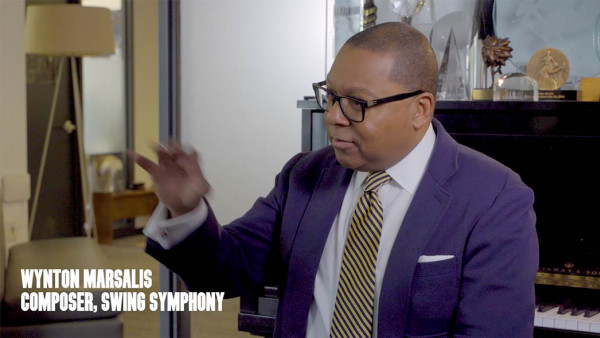 Videos
Videos
Wynton Marsalis breaks down “Swing Symphony” (Part 7)
-
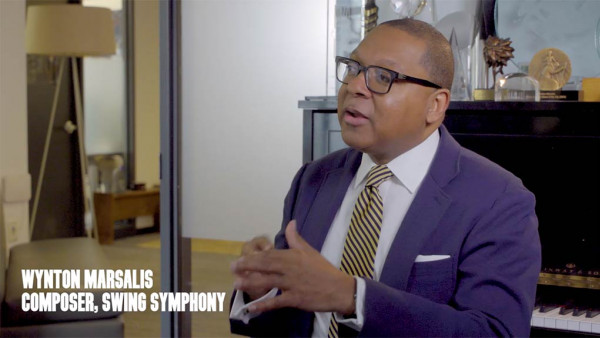 Videos
Videos
Wynton Marsalis breaks down “Swing Symphony” (Part 6)
-
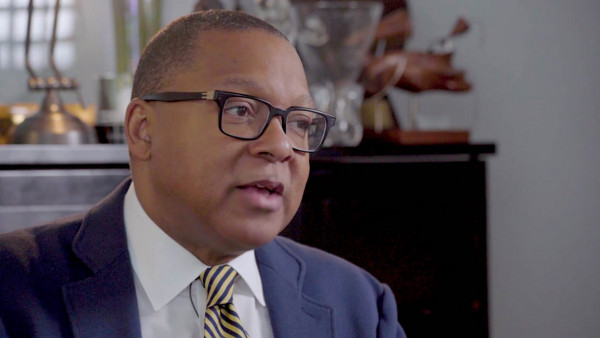 Videos
Videos
Wynton Marsalis breaks down “Swing Symphony” (Part 5)
-
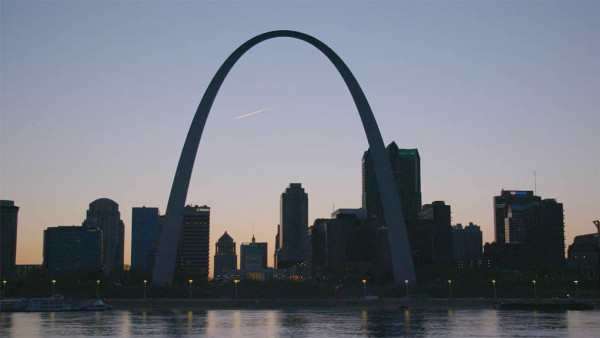 Videos
Videos
Wynton Marsalis breaks down “Swing Symphony” (Part 4)
-
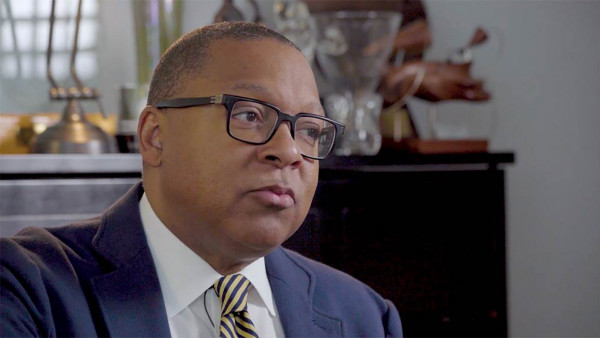 Videos
Videos
Wynton Marsalis breaks down “Swing Symphony” (Part 3)
-
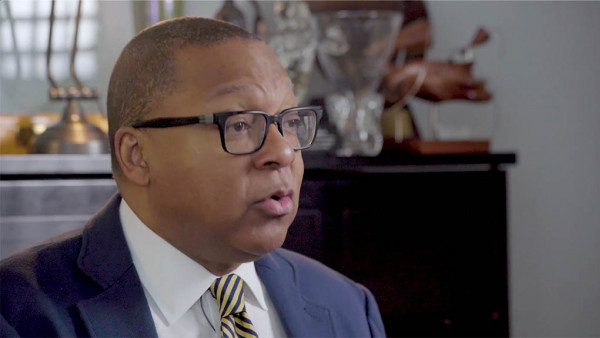 Videos
Videos
Wynton Marsalis breaks down “Swing Symphony” (Part 2)
-
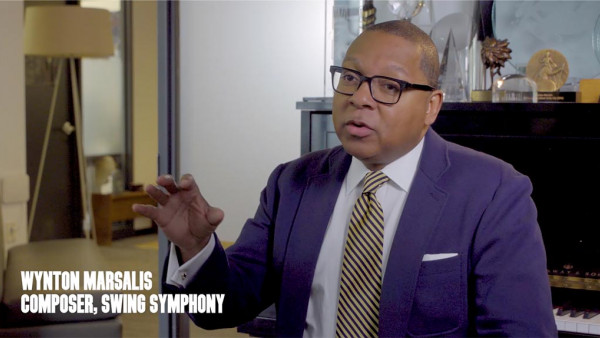 Videos
Videos
Wynton Marsalis breaks down “Swing Symphony” (Part 1)
-
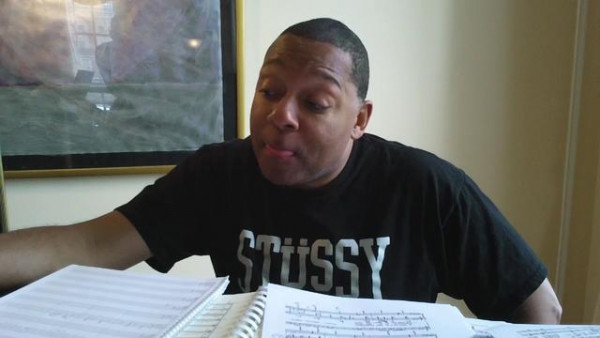 Videos
Videos
Wynton talking about Swing Symphony (Part 1)
